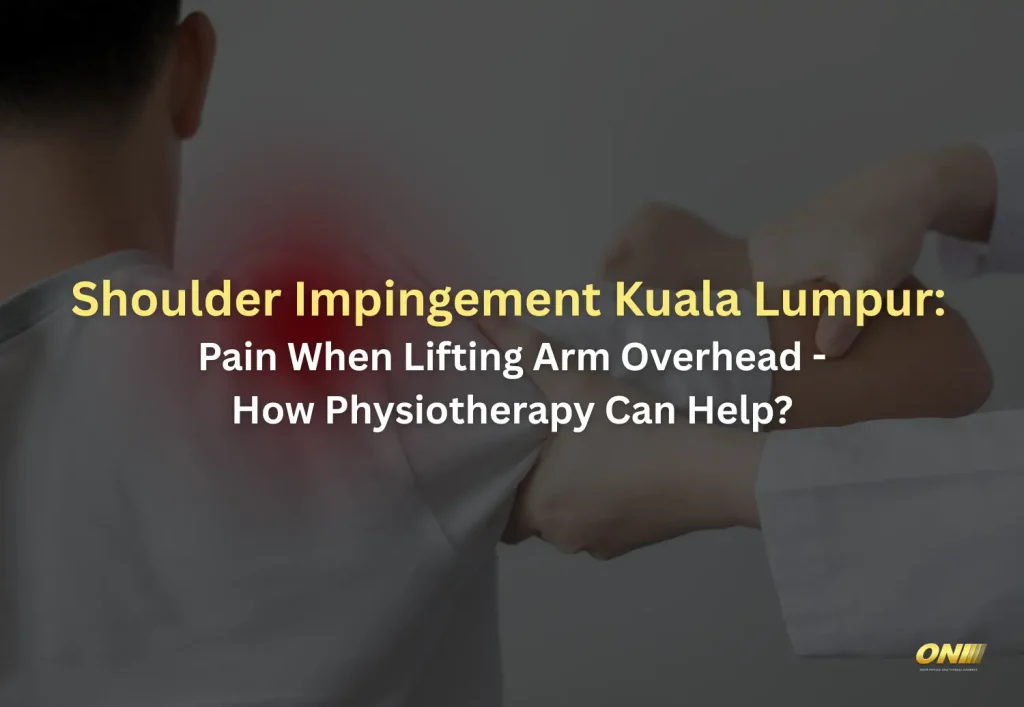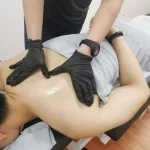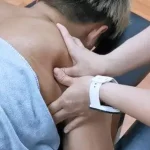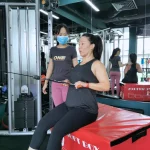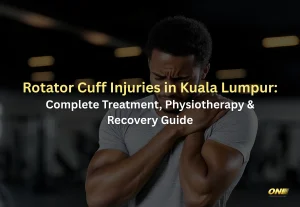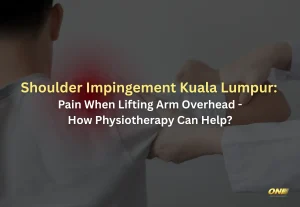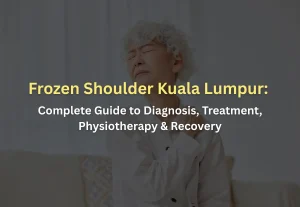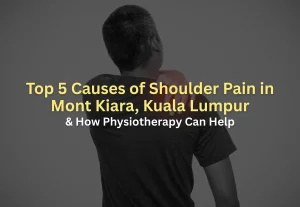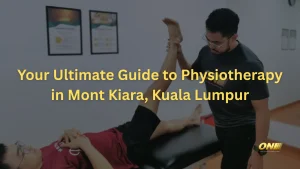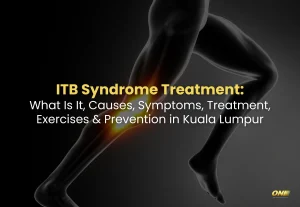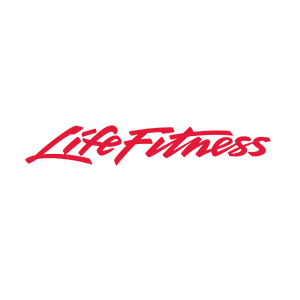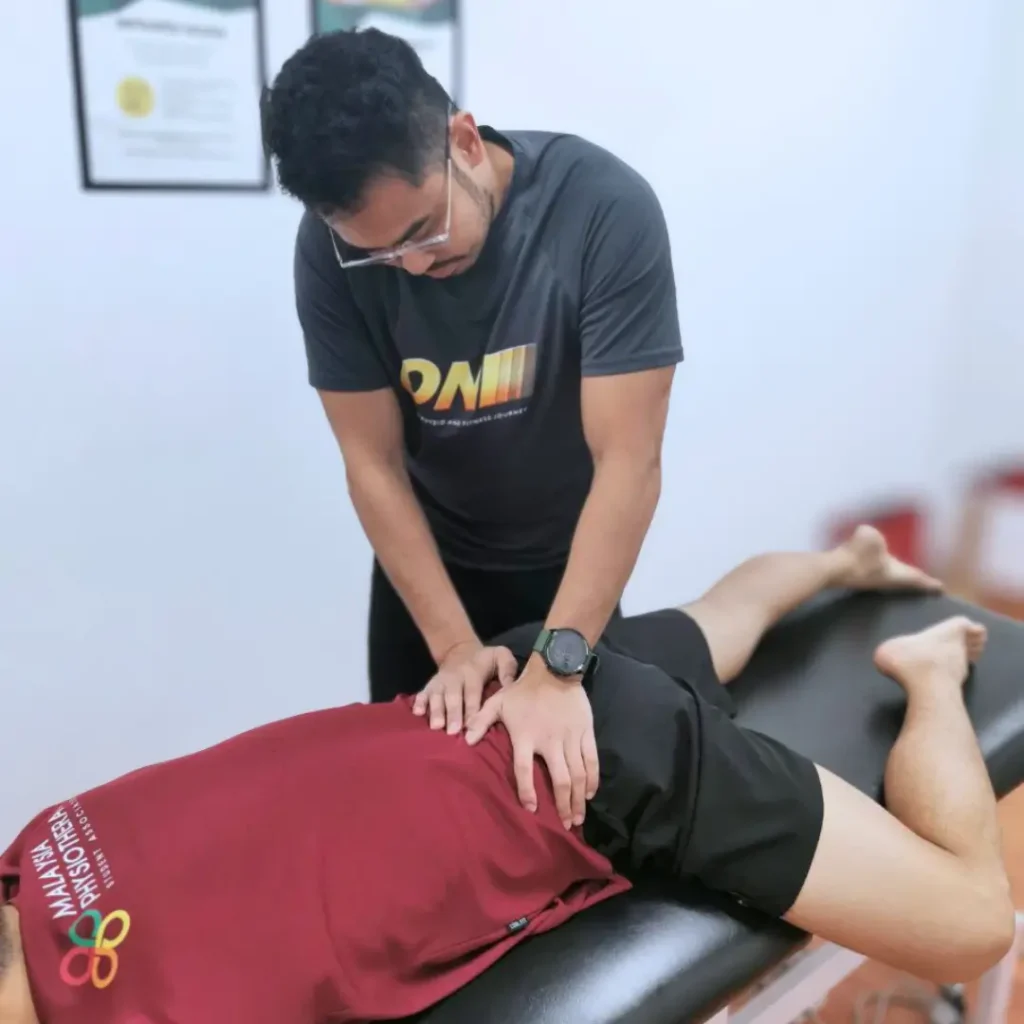Table of Contents
You reach up to grab something from the shelf, and there it is again. That sharp, nagging pain in your shoulder. Maybe it wakes you up at night when you roll over. Or perhaps you struggle to hook your bra or tuck in your shirt without wincing.
If this sounds familiar, you’re not alone. Shoulder impingement is one of the most common shoulder problems we see at our Mont Kiara center. The good news? With the right treatment approach, most people recover completely and get back to their normal lives.
This guide will walk you through everything you need to know about shoulder impingement, from understanding what’s happening in your shoulder to the exact steps we take to help you recover. We’ve helped many KL residents overcome this condition, and we’re confident we can help you too.
What Is Shoulder Impingement? Understanding the Condition
Let’s start with the basics. Shoulder impingement happens when the tendons in your shoulder get squeezed or compressed during arm movements. Think of it like a rope rubbing against a rock. Over time, that friction causes irritation, pain, and eventually damage.
The Mechanism Behind Shoulder Pain
Your shoulder is designed with a small space called the subacromial space. This is where your rotator cuff tendons live. When you raise your arm, these tendons glide smoothly underneath a bone called the acromion (the bony part you can feel on top of your shoulder).
In shoulder impingement, also known as Subacromial Impingement Syndrome (SIS), this space becomes too narrow. Your rotator cuff tendons get pinched between bones every time you lift your arm. It’s like trying to slide a thick book through a narrow mail slot. Something’s got to give.
Here’s what happens over time:
The compression cycle:
- Repeated pinching causes inflammation
- Inflamed tendons swell and take up more space
- Less space means more compression
- More compression leads to scar tissue formation
- Scar tissue makes tendons thicker and less flexible
- The cycle continues and worsens
Poor posture makes everything worse. If you spend hours hunched over a laptop (like most KL office workers), your shoulders roll forward. This position tilts your shoulder blade and reduces the subacromial space even more. Now your tendons are getting squeezed even when you’re not lifting your arm overhead.
Shoulder Impingement Symptoms
Not sure if you have shoulder impingement? Here are the telltale signs:
Pain patterns:
- Sharp pain when lifting your arm to the side, especially between 60 and 120 degrees (this is called the “painful arc“)
- Aching that gets worse at night, especially when lying on the affected shoulder
- Pain when reaching overhead (grabbing the MRT handrail, taking something from a high cabinet)
- Discomfort when reaching behind your back (tucking in your shirt, grabbing your wallet from your back pocket)
Weakness and limitation:
- Your shoulder feels weak, especially during overhead activities
- You avoid certain movements because you know they’ll hurt
- Difficulty serving in badminton or completing your golf backswing
- Trouble washing your hair or putting on a jacket
Daily life impacts:
- Interrupted sleep from shoulder pain
- Avoiding activities you enjoy
- Compensating with your other arm (which can lead to problems on that side too)
The key thing to understand: these symptoms don’t usually appear overnight. Most people notice a gradual increase in pain over weeks or months. You might push through it at first, but eventually, the pain becomes impossible to ignore.
Common Causes of Shoulder Impingement in Kuala Lumpur
Why does shoulder impingement happen? Usually, it’s a combination of factors building up over time.
Repetitive overhead activities:
- Playing badminton multiple times per week (very common in KL)
- Swimming laps at the condo pool
- Weight training with poor form, especially shoulder presses
- Repetitive work tasks (painting, construction, stocking shelves)
Poor posture from desk work:
This is huge for KL office workers. Sitting at a desk for 8-10 hours creates rounded shoulders and a forward head position. Your shoulder blade rotates forward, your chest muscles get tight, and your upper back muscles get weak. This is the perfect recipe for shoulder impingement.
Sports mechanics:
- Golf swing issues (especially if you have limited thoracic rotation)
- Improper badminton technique
- Gym exercises done with poor form (looking at you, bench press warriors)
Age and degeneration:
As we get older, tendons naturally become less flexible and more prone to injury. Small bone spurs can develop on the acromion, reducing the subacromial space even more.
Previous injuries:
An old shoulder injury that wasn’t fully rehabbed can change how your shoulder moves, setting you up for impingement later.
Risk Factors for KL Office Workers and Active Individuals
Let’s be honest about the KL lifestyle. Many of us are sitting in air-conditioned offices all week, then going hard at badminton or the gym on weekends. This “weekend warrior” pattern is tough on your shoulders.
Specific risk factors we see in Kuala Lumpur:
- Spending 40+ hours per week at a computer with poor ergonomics
- Forward head posture from constant phone use
- Air conditioning causing muscles to stay tense and tight
- Sedentary lifestyle weakening shoulder stabilizer muscles
- Sudden increases in activity (going from zero to hero at the gym)
- Playing badminton without proper warm-up or conditioning
- Neglecting upper back and shoulder strengthening exercises
If three or more of these apply to you, your risk of developing shoulder impingement is significantly higher.
Shoulder Impingement Diagnosis: What to Expect
When you come to ONI Physio Fitness for a shoulder assessment, we take our time to understand exactly what’s going on. This isn’t a rushed 10-minute appointment. We want to find the root cause of your pain, not just slap a band-aid on the symptoms.
Your first visit typically includes:
Detailed history discussion:
- When did the pain start?
- What makes it better or worse?
- What activities are you avoiding?
- Any previous shoulder injuries?
- What’s your daily routine and work setup like?
Physical examination:
We’ll assess your shoulder through several tests:
- Range of motion testing: We check how far you can move your arm in different directions and whether any positions are particularly painful
- Strength testing: Specific tests for each rotator cuff muscle to identify weakness
- Scapular movement: Watching how your shoulder blade moves (or doesn’t move) during arm raising
We do things differently at ONI Physio Fitness. While some clinics might give you a cookie-cutter exercise sheet and send you on your way, we take a comprehensive, individualized approach to every shoulder impingement case.
Why Our Shoulder Impingement Treatment Stands Out
We focus on active rehabilitation, not passive treatment: Yes, hands-on treatment feels good and provides temporary relief. But if we’re not teaching your body to move better and building strength, the pain will just come back. We use manual therapy to reduce pain and improve mobility, but the real magic happens with the exercise program.
We address the root cause: If your shoulder impingement is caused by poor desk posture, we’re going to work on that. If it’s from muscle imbalances, we’ll identify exactly which muscles need strengthening and which need stretching. If it’s from bad movement patterns, we’ll retrain them.
We track your progress objectively: Every few sessions, we retest your strength, range of motion, and functional abilities. This helps us know what’s working and when to progress your program. You’ll see measurable improvements, not just vague “it feels a bit better.”
We teach you to manage your own shoulder health: Our goal isn’t to keep you coming back forever. We want to give you the knowledge and tools to prevent this from happening again. By the end of treatment, you’ll understand your shoulder better than most people understand their cars.
Our Holistic Treatment Methodology
We combine the best of hands-on therapy with active exercise. Think of it like this: manual therapy prepares your shoulder for exercise, and exercise builds long-term resilience.
Treatment modalities we use:
- Manual therapy: Soft tissue release for tight muscles, joint mobilization to restore normal shoulder movement
- Dry needling: Targeting trigger points in the rotator cuff and upper back muscles
- Therapeutic ultrasound: Deep heating to promote tissue healing
- Kinesiology taping: Provides feedback for better posture and can reduce pain during activities
- Postural correction techniques: Teaching you how to sit, stand, and move with better shoulder mechanics
But remember, these are tools to support your recovery. The real work happens with exercise and movement retraining.
Estimated Shoulder Impingement Recovery Timeline
One of the first questions everyone asks: “How long until I’m better?”
The honest answer is that it depends on several factors (how long you’ve had it, severity, your commitment to the program). But here’s a realistic timeline based on our experience:
Weeks 1-2: Acute Phase (Pain Control)
What we’re focusing on:
- Reducing pain and inflammation
- Protecting your shoulder from further irritation
- Starting gentle movement to prevent stiffness
Treatment frequency: 2-3 times per week
What you’ll be doing:
- Gentle pendulum exercises (letting your arm swing naturally)
- Pain-free range of motion movements
- Pain management
- Postural awareness training
- Activity modifications (we’ll tell you what to avoid temporarily)
Expected outcome: You should notice about 30-40% reduction in pain. You’ll still be symptomatic, but the sharp, constant pain should start settling down.
Weeks 3-6: Restoration Phase (Getting Movement Back)
What we’re focusing on:
- Restoring full, pain-free range of motion
- Beginning to strengthen the rotator cuff
- Improving shoulder blade control
Treatment frequency: 2 times per week
What you’ll be doing:
- Progressive stretching for tight muscles (especially chest and front of shoulder)
- Scapular stabilization exercises (teaching your shoulder blade to move properly)
- Light resistance band work for the rotator cuff
- Continuing postural corrections
- Gradual return to light activities
Expected outcome: By week 6, you should have 60-70% improvement. You can do most daily activities without pain, though some overhead tasks might still be uncomfortable.
Weeks 7-12: Strengthening Phase (Building Resilience)
What we’re focusing on:
- Progressive strengthening of rotator cuff
- Building endurance (not just strength)
- Returning to sport or work activities
- Fine-tuning movement patterns
Treatment frequency: Once per week, plus your home program
What you’ll be doing:
- Moderate to heavy resistance training for shoulders and upper back
- Sport-specific exercises (badminton serves, golf swings, gym movements)
- Endurance training (higher reps, lower weight)
- Functional movement training
- Full return to activities with proper technique
Expected outcome: You should be 80-90% better. Most people return to all activities during this phase. Some residual achiness after heavy use is normal but should resolve quickly.
Weeks 12+: Maintenance and Prevention
What we’re focusing on:
- Long-term shoulder health
- Prevention of recurrence
- Continued strength building
Treatment frequency: Check-ins as needed (maybe once a month or as-needed basis)
What you’ll be doing:
- Maintaining a regular shoulder strengthening routine (2-3 times per week)
- Continuing good posture habits
- Proper warm-ups before sports
- Self-monitoring for early warning signs
Expected outcome: Complete resolution of symptoms. Your shoulder should feel strong and stable, and you should have the tools to manage any minor flare-ups on your own.
Important note: This timeline assumes you’re consistent with your exercises and following the treatment plan. If you only show up for appointments but don’t do your home program, recovery will take much longer.
Home Care Tips for Managing Shoulder Impingement
What you do between physiotherapy sessions matters just as much as the treatment itself. Here are practical tips to speed up your recovery:
Sleeping positions:
Night pain is one of the most frustrating parts of shoulder impingement. Try these strategies:
- Don’t sleep on the painful shoulder (seems obvious, but many people try)
- Sleep on your back with a small pillow under your arm to support it in a comfortable position
- Sleep on your good side with a pillow hugging to your chest to support the sore arm
- Prop yourself up with pillows if lying flat is uncomfortable
Ergonomic adjustments for KL office workers:
Your desk setup is probably contributing to your problem. Make these changes:
- Monitor at eye level so you’re not tilting your head forward
- Keyboard and mouse close so you’re not reaching forward
- Chair with good lumbar support to maintain natural spine curves
- Elbows at 90 degrees when typing
- Take breaks every 30 minutes to stand, walk, and move your shoulders
Activity modifications:
During the healing phase, work around your shoulder:
- Avoid overhead reaching as much as possible in the first few weeks
- Use a step stool instead of reaching high
- Modify your gym routine temporarily (no overhead presses, pull-ups, or aggressive chest work)
- Take breaks during repetitive tasks like painting or cleaning
Daily mobility routine:
Spend 5-10 minutes each morning doing gentle shoulder circles, arm swings, and stretches. Think of it like brushing your teeth for your shoulder. This keeps everything moving and reduces stiffness.
When to push through vs. when to rest:
This is tricky. Here’s a good rule:
- Mild discomfort during exercise is okay (3-4 out of 10 pain level) as long as it doesn’t linger afterward
- Sharp pain is a stop signal (don’t push through)
- Increased pain the next day means you overdid it (dial back slightly)
Simple Self-Assessment Guide for Shoulder Impingement
Think you might have shoulder impingement? Try these four simple tests at home. You’ll need a mirror and a quiet space.
Test 1: Painful Arc Test
How to do it:
- Stand in front of a mirror
- Start with your arm at your side
- Slowly raise your arm out to the side (like making a snow angel)
- Note if you feel pain and at what point
What it means:
- Pain between 60-120 degrees suggests impingement
- Pain through the entire range might indicate something else
- No pain is a good sign
Test 2: Reach Test
How to do it:
- Reach behind your back, trying to touch the opposite shoulder blade
- Try from both above (reaching over your shoulder) and below (reaching up from your lower back)
What it means:
- Significant difficulty or pain suggests shoulder impingement
- Compare both sides (some difference is normal, but major differences are concerning)
Test 3: Overhead Test
How to do it:
- Raise both arms straight up overhead
- Look in the mirror at the height each arm achieves
- Note any pain or limitation
What it means:
- If one arm doesn’t go as high, or causes pain, that’s a red flag
- Healthy shoulders should raise equally and pain-free
Test 4: Strength Test
How to do it:
- Raise your arm to the side to 90 degrees (parallel with the floor)
- Have someone push down gently on your arm while you resist
- Try to hold the position for 5 seconds
What it means:
- Weakness or pain suggests rotator cuff involvement
- Giving way immediately is especially concerning
Scoring Your Results
0-1 positive tests: You likely have minor irritation. Try home exercises and postural adjustments for 2 weeks. If not improving, book an assessment.
2-3 positive tests: You probably have moderate shoulder impingement. Book an assessment with us soon. The earlier we catch it, the faster you’ll recover.
4 positive tests or severe pain: You likely have significant impingement. Book an appointment this week. Don’t wait for it to “go away on its own.”
⚠️ Important Disclaimer:
This self-assessment is for educational purposes only and does not replace professional diagnosis. Everyone’s body is different, and these tests aren’t perfect. If you experience persistent shoulder pain, weakness, or night pain that disrupts your sleep, you should consult with a qualified physiotherapist for proper evaluation.
When to seek immediate help:
- Sudden inability to move your shoulder after an injury
- Severe pain that doesn’t respond to rest or pain medication
- Visible deformity of your shoulder
- Numbness or tingling down your arm
- Symptoms that are getting rapidly worse
Shoulder Impingement Prevention
Once you’ve recovered, the last thing you want is for the pain to come back. Prevention is all about maintaining what we’ve built during rehab.
Weekly maintenance routine:
You don’t need to do physiotherapy exercises forever, but keep these habits:
- Shoulder mobility work 3-4 times per week (5-10 minutes of arm circles, stretches)
- Strengthening 2 times per week (focusing on rotator cuff and upper back)
- Regular posture checks throughout your day
Ergonomic workspace habits:
Make your workspace shoulder-friendly:
- Stand every 30 minutes even if just for 30 seconds
- Stretch your chest and front of shoulders at lunch
- Keep your desk organized so you’re not constantly reaching for things
- Use a headset if you’re on the phone frequently
Proper warm-up before activities:
Don’t be the person who walks onto the badminton court cold. Spend 5-10 minutes:
- Gentle arm swings and circles
- Light resistance band work for rotator cuff
- Gradual progression from easy to hard (don’t start with your best smash)
Managing training loads:
Managing training loads:
The “too much, too soon” mistake is super common, especially among KL weekend warriors:
- Increase activity gradually (10% per week is a safe guideline)
- Don’t jump from zero activity to intense badminton every Saturday
- Balance pushing and pulling exercises at the gym (for every chest press, do a row)
- Listen to warning signs (mild achiness after activity is your shoulder saying “ease up a bit”)
Specific Tips for KL Activities
For badminton players:
- Work on your serving technique with a coach (poor mechanics cause lots of shoulder problems)
- Don’t play through pain (taking one week off now beats taking three months off later)
- Strengthen during off-season so you’re prepared when league starts
- Allow recovery time between matches (your shoulder needs 48 hours to fully recover)
For golfers:
- Get your swing analyzed (limited thoracic rotation often shows up as shoulder pain)
- Work on thoracic mobility (rotating through your mid-back instead of forcing it through your shoulder)
- Start your round with pitch shots before moving to full swings
- Strengthen your core to support the rotational demands
For gym-goers:
- Fix your bench press form (elbows should be at 45 degrees, not 90)
- Do twice as many pulling exercises as pushing exercises (2 rows for every 1 chest press)
- Don’t max out on overhead presses every week (your shoulder needs variety in load)
- Focus on controlled movement not just moving weight
For office workers:
- Set up a standing desk or alternate sitting and standing
- Do shoulder rolls every time you finish a task
- Stretch your chest in a doorway once mid-morning and once mid-afternoon
- Strengthen your upper back to counteract all the sitting
Frequently Asked Questions About Shoulder Impingement
How long does shoulder impingement take to heal?
Most people see significant improvement in 6-12 weeks with consistent physiotherapy and exercise. However, complete resolution can take 3-6 months depending on severity and how long you’ve had the problem. Chronic cases that have been going on for years will take longer than acute cases caught early.
The biggest factor in recovery time? Your consistency with the home exercise program. People who do their exercises regularly recover much faster than those who only work on their shoulder during clinic appointments.
Can shoulder impingement heal on its own?
Sometimes, if you catch it very early and the cause was a temporary increase in activity. But most cases don’t resolve without active treatment. In fact, shoulder impingement often gets progressively worse over time as tendons become more damaged and scar tissue builds up.
Hoping it will go away on its own usually just means you’re dealing with a worse problem down the road.
What happens if shoulder impingement is left untreated?
The longer it goes on, the worse it gets. Here’s the typical progression:
- Early stage: Intermittent pain with certain activities
- Middle stage: Pain during most overhead activities, night pain starts
- Advanced stage: Constant pain, significant weakness, difficulty with basic tasks
- End stage: Possible complete rotator cuff tear requiring surgery
Don’t let it get to the advanced stages. Early treatment is easier, faster, and more effective.
Is shoulder impingement the same as a rotator cuff tear?
No, but they’re related. Shoulder impingement is the compression and irritation of the rotator cuff tendons. A rotator cuff tear means the tendon has actually ripped apart.
Think of it like a rope rubbing on a rock (impingement) versus a rope that has frayed so much it snaps (tear). Untreated impingement can eventually lead to a tear, which is why early treatment matters.
The good news: impingement usually responds well to physiotherapy. Tears often need more aggressive treatment, and sometimes surgery.
Can I continue playing badminton with shoulder impingement?
It depends on severity and pain levels. Here’s our general guidance:
Mild cases: You can usually continue playing with modifications (lighter play, fewer games, better warm-up)
Moderate cases: You need to take a break for 2-4 weeks while we get the pain under control, then gradually return
Severe cases: You need to stop completely until we’ve made significant progress
Playing through significant pain will make it worse and extend your recovery time. Taking 2-3 weeks off now beats taking 6 months off later because you’ve developed a full rotator cuff tear.
Do I need surgery for shoulder impingement?
Very rarely. About 70-80% of people recover completely with shoulder physiotherapy alone. Surgery is only considered if:
- You’ve done proper physiotherapy for 6-12 months without improvement
- You have a complete rotator cuff tear (not just impingement)
- You have significant bone spurs that are causing mechanical obstruction
- Imaging shows structural problems that can’t be addressed with exercise
Even if you do need surgery eventually, you should try physiotherapy first. The exercises and strengthening you do now will help your surgical outcome if you do need the procedure.
Take the First Step Toward a Pain-Free Shoulder
Shoulder impingement doesn’t have to control your life. With the right approach, most people recover completely and return to all the activities they love. Whether it’s playing badminton with friends, working out at the gym, or simply reaching overhead without pain, you can get there.
The key is starting treatment before the problem gets worse. Every week you wait, those tendons are getting more irritated and damaged. The earlier we intervene, the faster and easier your recovery will be.
At ONI Physio Fitness in Mont Kiara, we’ve helped many KL residents overcome shoulder impingement. We understand the lifestyle factors that contribute to shoulder problems in our city, from long desk hours to weekend sports. We know how to address these specific challenges.
Our approach combines hands-on treatment with progressive exercise and education. We don’t just want you to feel better temporarily. We want to give you a shoulder that’s stronger, more resilient, and less likely to have problems in the future.
Click here to book an appointment with us today.

